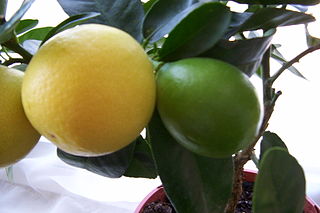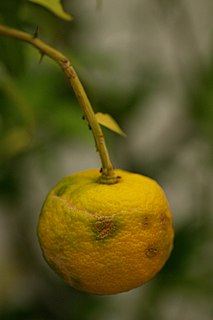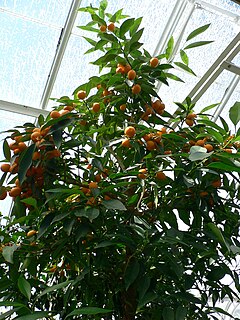Related Research Articles

Kumquats, or cumquats in Australian English, are a group of small fruit-bearing trees in the flowering plant family Rutaceae. They were previously classified as forming the now-historical genus Fortunella, or placed within Citrus, sensu lato.

Citrus is a genus of flowering trees and shrubs in the rue family, Rutaceae. Plants in the genus produce citrus fruits, including important crops such as oranges, lemons, grapefruits, pomelos, and limes. The genus Citrus is native to South Asia, East Asia, Southeast Asia, Melanesia, and Australia. Various citrus species have been used and domesticated by indigenous cultures in these areas since ancient times. From there its cultivation spread into Micronesia and Polynesia by the Austronesian expansion ; and to the Middle East and the Mediterranean via the incense trade route, and onwards to Europe.

Calamansi, also known as calamondin, Philippine lime, or Philippine lemon, is an economically important citrus hybrid predominantly cultivated in the Philippines. It is native to the Philippines, Borneo, Sumatra, and Sulawesi in Indonesia in Southeast Asia, as well as southern China and Taiwan in East Asia. Calamansi is ubiquitous in traditional Filipino cuisine. It is naturally very sour, and is used in various condiments, beverages, dishes, marinades, and preserves. Calamansi is also used as an ingredient in Malaysian and Indonesian cuisines.

The mandarin orange, also known as the mandarin or mandarine, is a small citrus tree fruit. Treated as a distinct species of orange, it is usually eaten plain or in fruit salads. Tangerines are a group of orange-coloured citrus fruit consisting of hybrids of mandarin orange with some pomelo contribution.

A lime, is a citrus fruit, which is typically round, green in color, 3–6 centimetres (1.2–2.4 in) in diameter, and contains acidic juice vesicles.

The pomelo, pummelo, or in scientific terms Citrus maxima or Citrus grandis, is the largest citrus fruit from the family Rutaceae and the principal ancestor of the grapefruit. It is a natural, i.e., non-hybrid, citrus fruit, native to Southeast Asia. Similar in taste to a sweet grapefruit, the pomelo is commonly consumed and used for festive occasions throughout Southeast Asia. Like the grapefruit, the pomelo has the potential for drug interactions.

The limequat is a citrofortunella hybrid that is the result of a cross between the Key lime and the kumquat, hybridized by Walter Tennyson Swingle in 1909.

The Key lime is a citrus hybrid native to tropical Southeast Asia. It has a spherical fruit, 25–50 mm (1–2 in) in diameter. The Key lime is usually picked while it is still green, but it becomes yellow when ripe.

An oroblanco, oro blanco, Pomelit (Israel) or sweetie is a sweet seedless citrus hybrid fruit similar to grapefruit. It is often referred to as oroblanco grapefruit.

The Nippon orangequat is a cross between a Satsuma mandarin and a Meiwa kumquat, hybridized by Dr. Eugene May of the USDA and introduced in 1932, and is a member of the citrofortunella group. 'Nippon' is the only named cultivar.

A seedless fruit is a fruit developed to possess no mature seeds. As consumption of seedless fruits is generally easier and more convenient, they are considered commercially valuable.

A number of citrus fruits are grown in or strongly associated with Japan. Many of these fruits are of Chinese origin, but have been modified or specially bred for cultivation in Japan.

Citrus macroptera, also known as hatkhora, satkara,shatkora, hatxora, cabuyao, Melanesian papeda, or wild orange, is a semi-wild species of citrus native to Bangladesh, Malesia and Melanesia.

Citrofortunella are a large group of commercial hybrids that cross the kumquat with other citrus. In the system of citrus taxonomy established by Swingle, kumquats were placed in a different genus, Fortunella, from Citrus, which included citron, mandarin orange, pomelo and papedas. The result of genetic crosses between kumquats and these other citrus would then be intergeneric hybrids, so a novel genus name was coined for them in 1975, by compounding the names of the contributing genera to form Citrofortunella. That the genus is of a hybrid nature is represented by a multiplication sign before the genus name, for example × Citrofortunella microcarpa. Recent phylogenetic work has shown kumquats to fall within Citrus rather than belonging to a distinct genus, meaning these would no longer be considered intergeneric hybrids, and use of Citrofortunella as a distinct genus name for these hybrids loses taxonomic validity. All would be placed instead within Citrus.
The citrangequat is a trigeneric citrus hybrid of a citrange and a kumquat, developed by Walter Swingle at Eustis, Florida, in 1909. Citrangequats are bitter in taste, but are considered edible by some at the peak of their maturity. Three named cultivars exist:

Clymenia is a small genus of flowering plants in the family Rutaceae with two species. The genus is often included in Citrus.

The Melogold or Melogold grapefruit is a citrus hybrid similar to the oroblanco; both result from a cross between the pomelo and the grapefruit and is a fruit similar to a sweet grapefruit.

Citrus taxonomy refers to the botanical classification of the species, varieties, cultivars, and graft hybrids within the genus Citrus and related genera, found in cultivation and in the wild.
Citrus rootstock are plants used as rootstock for citrus plants. A rootstock plant must be compatible for scion grafting, and resistant to common threats, such as drought, frost, and common citrus diseases.
The mangshanyegan is a wild citrus fruit species.
References
- 1 2 Procimequat at Citrus Variety Collection website.
- ↑ "Citrus (X Citrus) Fortunella hindsii x ('Eustis' Limequat) Procimequat Procimequat from Woodlanders, Inc". woodlanders.net.
- ↑ "Procimequat "A very interesting and complex hybrid"". Tropical Fruit Forum.